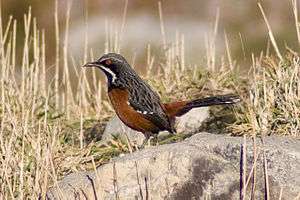Rockjumper
| Rockjumpers | |
|---|---|
 | |
| Cape rockjumper | |
| Scientific classification | |
| Kingdom: | Animalia |
| Phylum: | Chordata |
| Class: | Aves |
| Order: | Passeriformes |
| Suborder: | Passeri |
| Family: | Chaetopidae |
| Genus: | Chaetops Swainson, 1832 |
| Species | |
|
C. frenatus | |
The rockjumpers are medium-sized insectivorous or omnivorous birds in the genus Chaetops, which constitutes the entire family Chaetopidae. The two species, the Cape rockjumper, Chaetops frenatus, and the Drakensberg rockjumper, Chaetops aurantius, are endemic residents of southern Africa.[1] The Cape rockjumper is a resident of the West Cape and south-west East Cape, and the orange-breasted (or Drakensberg) rockjumper is distributed in the Lesotho Highlands and areas surrounding them in South Africa. The two rockjumpers have been treated as separate species but differ in size and plumage. The ranges do not overlap, but come close to doing so.
Taxonomy and systematics
Originally, these birds were placed in the thrushes, and they have also been placed with the Old World warblers and the babblers, but recent DNA studies indicate these birds are actually primitive passerines most closely related to the rockfowl (Picatharthidae), a family in which they are sometimes placed.[2]
Description
These are small birds with mostly brown and red plumage. Both species have long, white tipped black tails, black throats, broad white submoustachial lines, rufous or orange bellies and rumps and grey and black patterned backs and wings.[1] The iris is red and the bills and legs are black. Their wings are very small and they do not fly very often. They spend most of their lives running and jumping among rocks and grasses while hunting insects. A range of insects are taken, including caterpillars, moths, grasshoppers, beetles and flies. In addition to insects other prey include lizards and geckos, amphibians, scorpions, annelid worms and spiders.
Behaviour and ecology
They are monogamous and pairs establish territories which are defended year round. In the Cape rockjumper the territories vary in size from 4–11 ha (10–27 acres). Both species employ helpers, usually the young of previous broods, to aid the breeding pair in raising the young.[3] Nests are built out of grass on the ground (in contrast to rockfowl, which build mud nests in colonies).[2] The clutch size is two eggs for the Cape and two to three eggs for the Drakensberg.[1] Both sexes incubate the clutch for 19–21 days. The chicks are fed by the parents and helpers for thirty days, but they leave the nest sooner than that.
References
- 1 2 3 del Hoyo, J.; Elliot, A. & Christie D. (editors). (2007). Handbook of the Birds of the World. Volume 12: Picathartes to Tits and Chickadees. Lynx Edicions. ISBN 978-84-96553-42-2
- 1 2 Thompson, Hazell S. (2003). "Rockjumpers and Rockfowl". In Christopher Perrins (Ed.). Firefly Encyclopedia of Birds. Firefly Books. p. 515. ISBN 1-55297-777-3.
- ↑ Holmes R, Frauenknecht B, & M Du Plessis (2002) "Breeding System of the Cape Rockjumper, a South African Fynbos Endemic" Condor 104 (1): 188–192 doi:10.1650/0010-5422(2002)104[0188:BSOTCR]2.0.CO;2